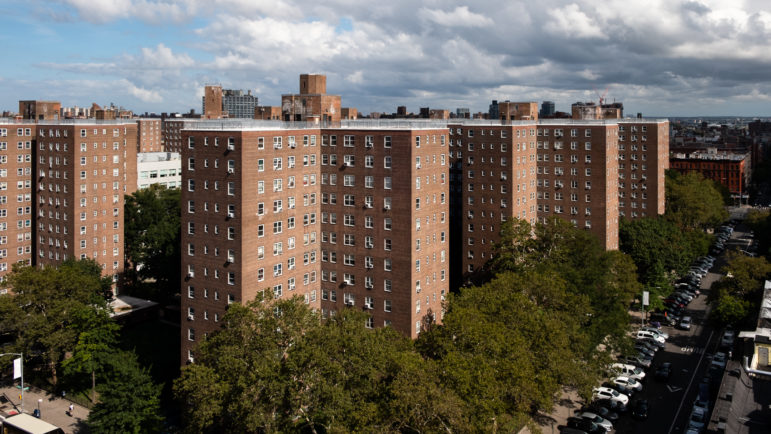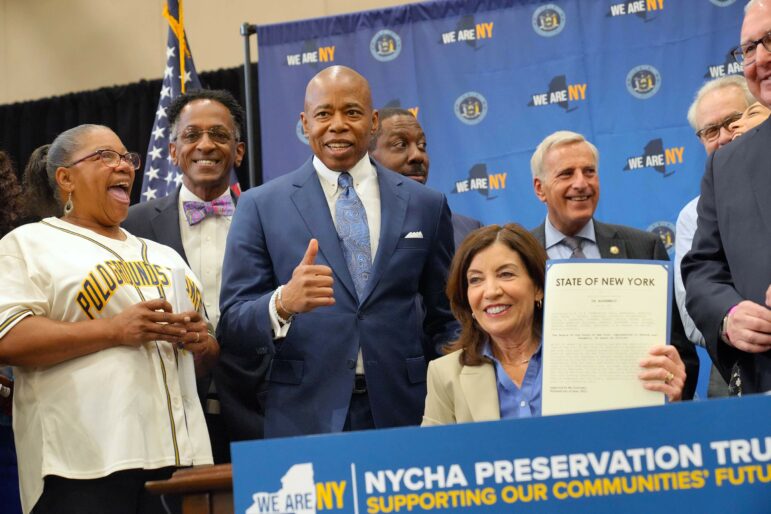The heads of household in 25,000 NYCHA apartments will soon have an opportunity to vote on how to best raise capital and complete repairs in their individual complexes, choosing from one of three funding models. For those elections to be considered valid, at least 20 percent of heads of household named on leases must cast a ballot, new rules state, though NYCHA says it will “strive to achieve turnout far greater.”

Adi Talwar
A view of NYCHA’s St. Nicholas Houses near the intersection of Frederick Douglass Boulevard and West 127th Street in Harlem.Ballots from one in five lease-holders are all it will take to complete a permanent, binding vote on the future funding and management of New York City Housing Authority developments, according to election rules issued Monday by the public housing agency.
Following decades of disinvestment in New York City’s public housing stock, the heads of household in 25,000 NYCHA apartments will soon have an opportunity to choose how to best raise capital and complete repairs in their individual complexes: by turning a development over to private management, by entering into a newly-created form of public ownership or by maintaining the current public housing model.
For those elections to be considered valid, at least 20 percent of heads of household named on leases must cast a ballot, the rules state. Draft rules issued by NYCHA in October set the voter threshold at 10 percent, driving significant opposition from tenants who called it “shameful,” “absurdly low” and a “sham democratic process” during a public comment period that ended last month.
Many tenants, meanwhile, say they will need more details on the different plans to make an informed choice and worry transformative decisions will still be made by a small minority of residents. “I understand that NYCHA needs funding otherwise nothing is going to change,” said Gowanus Houses President Andreas Tyre. “But you could lose that safety net and that’s a fear of mine.”’
The elections will take place as hundreds of thousands of residents, the public housing authority and elected officials contemplate how to raise revenue to correct an estimated $40 billion in capital needs while preserving a vital source of affordable housing. The traditional public housing model has faced years of underfunding, disregard and mismanagement, with residents suffering the consequences in the form of busted boilers, broken elevators and toxic lead paint.
Thousands of tenants may choose to shift their developments into two alternative structures. One option, the Rental Assistance Demonstration-Permanent Affordability Commitment Together (RAD-PACT) program, is already underway at 58 developments that have been turned over to private corporations that handle management, rent collection and renovations.
State lawmakers in June approved a plan to create a third option that would allow NYCHA to transfer developments into a benefit corporation known as the Preservation Trust. Billed as a publicly-controlled alternative to RAD-PACT, the Preservation Trust will have the power to issue bonds and borrow money for sorely needed capital improvements. Both RAD-PACT and the Trust switch apartment subsidies from Section 9 to the Section 8 program, which comes with more federal funding and is traditionally used on the private market.
The Preservation Trust legislation, signed by Gov. Kathy Hochul and backed by Mayor Eric Adams, included a stipulation that NYCHA create a minimum voter threshold for elections to be considered valid, giving tenants a chance to weigh in instead of having a key decision about their future imposed on them.
“Central to the Act is providing residents the power to determine the future of their developments: developments will only transfer to the Public Housing Preservation Trust if the residents of that development vote to join the Trust,” reads a version of the final rules issued by NYCHA.
The opt-in clause included in the legislation helped secure support from lawmakers but raised concerns among residents that a small minority of informed tenants could determine the lasting fate of an entire complex.
The 10 percent voter threshold initially proposed in NYCHA’s draft rules confirmed those fears for many residents. About a third of the 192 public comments submitted in response to the draft rules took aim at the low threshold. All told, 62 people criticized the 10 percent figure, with 51 commenters proposing a specific, higher threshold, according to an analysis by NYCHA’s voting rules working group.
“The voting percentage should be increased to 80 percent of the development, 10 percent is not a majority and the majority should rule!” wrote one tenant of the Rutgers Houses on the Lowest East Side in November. “Voting should be democratic – if 51% or higher of people make a decision then that’s the majority + should be respected. 10% is ridiculous,” wrote another. Both names were redacted from the public comments shared with City Limits.
One person who submitted a comment by email called the 10 percent threshold “shameful.”
“What kind of sham democratic process is this?” they wrote. “This is a major irreversible decision but few NYCHA tenants know or understand the process, in part because NYCHA has created such a confusing timeline for voting and hasn’t clarified what’s truly at stake.”
Working group member Victor Bach, the recently retired senior housing policy analyst at the Community Service Society (a City Limits funder), said discussions over the voter threshold took up more of the task force’s time and attention than any other aspect of the procedure. But he declined to discuss the conversations out of respect for the private nature of the committee’s work.
“I wish it were higher, but I’m not sure that conforms with reality,” Bach said.
The working group considered general election turnout data among NYCHA residents from 2007 to 2021. The data presented by NYCHA showed that an average of 21.7 percent of registered voters cast ballots in general elections during that 14-year period. But turnout ranged from 45.3 percent during the 2016 presidential election to 3.7 percent in 2011, an off-year vote that featured races for Queens and Bronx district attorney where long-time incumbents were running unopposed.
Howard Houses Tenant Association President Naomi Johnson said the group met for months to negotiate “really tough issues in an intelligent and respectful way.”
“Some of us disagreed at times, but everyone knew that we were all working with the residents’ interests in mind,” Johnson said in a statement. “With these rules in place, I am confident that residents will come together to do what is best for their developments.”
A spokesperson for NYCHA said the authority took the public comments to heart in making a final decision on the quorum in consultation with resident leaders, policy experts and tenant advocates.
“We are grateful for their hard work and consideration throughout this collaborative process,” the spokesperson said. “NYCHA and the working group met weekly for four months, held eight public town hall meetings, accepted public comments for nearly two months and included all public voices who reached out in its decision making process.”
Under the rules set to be issued Tuesday, “third parties with expertise in elections” will conduct the vote, investigate any allegations of irregularities and certify the vote results. Tenants will have a 30-day period to cast their ballots by mail or online, as well as a 10-day in-person voting period. A vote will be null and void if fewer than 20 percent of heads of households cast ballots and a run-off will be held in the event of a tie between two of the options.
But, the voting procedure document adds, “NYCHA will strive to achieve turnout far greater than this minimum threshold through resident engagement.” After six elections are completed, the authority will reconsider revising the minimum turnout threshold.
The rules define “eligible voters” as any resident over the age of 18 who has signed a lease, including in cases with “co-Heads of Household.” But the rules don’t specify whether multiple votes from one apartment would be used to reach the 20 percent threshold. A NYCHA official said they could factor into the 20 percent so long as the voters are co-heads of household.
State Sen. Julia Salazar Brooklyn, who introduced the Preservation Trust legislation that passed into law, said NYCHA seemed responsive to tenant concerns by agreeing to lift the threshold to 20 percent based on input from the tenant working group.
“Going back to the resident working group after the draft regulations and after the public comment period and saying, ‘We need to increase this threshold’ was the most important change they could make to give the vote credibility and to encourage turnout,” Salazar said. “The ideal would be 100 percent turnout. I think we should aspire to higher than 20 percent, but I think it’s a reasonable minimum standard for election results to be valid.”

Ed Reed/Mayoral Photography Office.
Mayor Eric Adams and New York Gov. Kathy Hochul at the signing of legislation to create the New York City Housing Authority (NYCHA) Preservation Trust in June.
But several tenants who spoke with City Limits Monday said they still disagree with turning over the future of their developments to the will of so few residents.
Barbara Williams, the former president of the Polo Grounds Tenant Association, said she would like to see the voter threshold increased to 51 percent of residents, or at the very least 40 percent.
“I think that might be sufficient because this is going to affect people’s lives going forward,” said Williams, 74, who has lived at the Polo Grounds since 1988.
NYCHA, she said, has played a crucial role in preserving affordable housing in New York City, despite worsening conditions that stem from years of disinvestment and mismanagement. She said the current conditions are now used to justify a transformative change that will forever erode public housing in the United States. “I think this was something strategically done to allow public housing to get into the condition it’s in,” she said.
Manny Martinez, South Jamaica Houses Residents Association president and chair of Queens South on the Citywide Council of Presidents, also said a larger portion of residents’ votes should be required.
“It will be a decision made by a few people for many,” Martinez said. “Voting is a huge part of our society. This is a vote to change your rights.”
Many residents do not yet know about their options, or realize that they may be called on to vote at all, according to an August survey of 293 public housing residents by the Community Service Society.
The survey, part of the organization’s annual report on the experience of low-income renters, saw 39 percent of respondents say they did not have enough information to determine whether they would prefer to enter the Trust, convert their buildings to RAD-PACT or maintain the status quo. About 29 percent said they preferred RAD-PACT, 18 percent said the Trust and 13 percent said they’d prefer their development to remain in Section 9 public housing, the results show.
“Before any development faces the preservation decision process, it is necessary that residents be informed and provided with even-handed, reliable, resident-friendly information about the three choices,” the report’s authors wrote.
In its voting procedure rules, NYCHA committed to presenting tenants “with clear and comprehensive information on the three voting options” and providing a physical needs assessment that lays out the development’s capital needs.
“NYCHA understands significant outreach will be required before any vote is held pursuant to these Voting Procedures,” the new rules state. “They must understand their rights through the Trust and within PACT, as well as how those rights compare to their existing rights in Section 9.”
“And NYCHA must provide residents the opportunity to raise their questions and concerns and to have them addressed,” the document continues.
The authority said it will conduct “comprehensive outreach over the 100 days” before the vote.
The level of outreach will be crucial for actually engaging tenants, said Bronx River Houses resident Maria Arnold, 65. She said many of her neighbors have not even heard of the Preservation Trust, while others do not know the difference between that plan and RAD-PACT.
“People need to be better educated before they are asked to vote on something,” she said.
City Limits is starting a new beat dedicated exclusively to covering NYCHA. Send us feedback and story ideas to NYCHA@citylimits.flywheelstaging.com.









3 thoughts on “Under New Election Rules, 20% of Households Could Determine Fate of NYCHA Developments”
The turnout is usually not much different from what is expected. as always
Oligarchical rule is the modus operandi of the unDemocratic party whose housing policy is loaves of government dollars in the pockets of the housing developer and management oligarchs… while tenants are given crumbs of housing value.
I think this newly enacted election rule will bring more positive and fair results